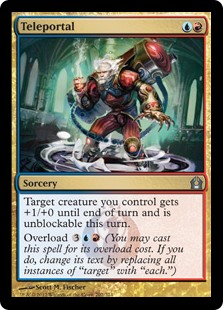A few years ago, when the big debate in the Magic community was ongoing between the use of Hexproof versus Shroud, one of the often cited arguments by Magic R&D in their decision to go ahead with the more intuitive but more rife for abuse Hexproof was that a good designer shouldn’t fight human nature. That is, if a substantial part of the player base assumed that some part of the game behaved in a certain way, it was more worthwhile to work with that mentality than continually fight against it. Many players, they said, assumed Shroud worked the way that Hexproof (as it become known) did anyway, so they might as well run with that mentality rather than spend the energy trying to constantly correct the player base.
Such things happen in Magic more than many realize. While the Shroud v Hexproof fight was (and continues) to be waged, there many other more subtle assumptions players make all the time that never get the same kind of fanfare. Whether it’s a case of believing that a color still did something based on its ability to do so in the past, or a widely misunderstood rule that routinely trips people up, it’s hard even for the die hard fans to keep on top of the game’s continually hanging mosaic of traits and abilities. What often starts off as informed knowledge in time gives way to presumptions and expectations.
Expectations are a funny thing. Mostly because they will continue to persist until something is pointed out to the contrary (and sometimes even beyond that).
Consider for instance:
- Black has traditionally been known as the color of unrestricted card tutoring and efficient creature spot removal cards. Yet both of those have been scaled back significantly in the last couple years.
- White is similarly known as the damage mitigation color, but cards involving Protection and damage prevention have also declined steeply in the last few years. Moreover, the color most capable of preventing combat damage entirely typically isn’t even White – it’s Green.
- Many have assumed that the insane rise of creatures with Enter the Battlefield triggers also means that modern sets have a continually larger percentage of creatures. However, this isn’t true. While the percentage of creatures vs other nonland cards in older sets is indeed much smaller (i.e. 39% in Urza’s Saga or 48% in Invasion), the range for modern era sets has been fairly consistent at around 52-57%.
Or, perhaps, consider this: Blue is widely known as the color of unblockable creatures. This much is true. As is the color’s ability to occasionally give that ability to a single creature. Granting that trait to your entire army, on the other hand, is actually quite rare for Blue. That effect, worded slightly differently…is actually much more of a Red thing. Or a combination of the two, as in the case of this week’s card.
Today we have: Teleportal

Name: Teleportal
Edition: Return to Ravnica / Modern Masters 2017
Rarity: Uncommon
Focus: Evasion
Highlights: Teleportal is the latest card in a series of recent article selections to highlight the notion that Commander cards don’t need to be broken, expensive, or complicated for them to be useful additions to your deck. With relatively little fanfare, Teleportal provides one simple effect in the hopes of giving you a well-timed upper hand. And if done correctly, the payoff will be pretty hard to miss.
Teleportal doesn’t show up claiming to offer a deep mystery on how it works or what it’s purpose is. In fact, for an Izzet-specific card, it’s initial presence is pretty unremarkable. The card can essentially be used in two forms thanks to the Overload ability: singularly or or army-wide. For two mana, Teleportal slightly buffs one of your creatures and makes it unblockable for the turn. For just three more – an incredibly economical five – it does the same for all of you creatures on the battlefield.
In either case, this card ensures that you can do damage to one of your opponents. If mana or time are a concern, the singular use option for Teleportal lets you make a tactical attack, be it with a large hulking creature or one that provides some sort of bonus upon damaging your opponent. By contrast, by allowing you to swing your entire board at someone with no chance of them being able to block it, this humble little card generates the means to do substantial damage to your opponent – or deliver a knock-out blow to someone entirely. As cost to benefit ratios go, it’s pretty hard to beat the potential combat advantage this gives you, and it being a spell versus a permanent on the board means that it’s that much harder to stop (or see coming).
But, of course, I assume you knew all this already. I expect you figured out its merit merely by reading the card itself.
Keep an eye out for us to be regularly featuring other more accessible-but-worth-it Commander cards going forward. In the meantime, we’ll keep the light on for you.
![]()
You can discuss this article over on our social media!
